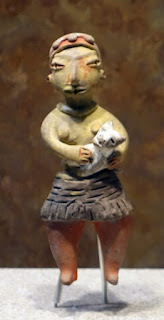1. Prehistoric Art
Some notes taken from the BBC documentary How Art Made the World, with Dr. Nigel Spivey.
NOTE: When dealing with time before the common era BC, we count years backwards. So, the higher the number, the farther back in time.
What makes prehistoric art so fascinating is that it presents clues as to our past, and yet these clues often raise more questions than they answer. They are filled with mystery that may never be uncovered. For example:
1. People have a great ability to see and understand pictures and symbols, even crude ones. It sets us apart from all other animal species, even our closest relatives, the chimpanzees. Why? And when did this start? And, what role did art play in the formation of the first civilizations? This is one of the great mysteries of mankind. Was art the catalyst for civilization, or simply a byproduct?
2. At what point did people begin to appreciate aesthetic beauty and skill? Was it when they started making "art"? as in Cave paintings? Or was it earlier? Archaeologists have found, for example, perfect example of prehistoric stone knives that were never used, but instead placed in tombs:
What's the point in making a hand axe if you're never going to use it?
3. Homo sapiens have lived for about 200,000 years, but for over 150,000 years we didn’t paint anything. Then, about 35,000-40,000 years ago we changed. We began painting in caves, carving stone figurines, carving flutes from bones, and making jewelry from shells. This new trend is what first separated humans from all the other animals on Earth.
4. One theory is that prehistoric artists wanted to represent the world around them, like we do today. But today, we draw everything. Why did cave artists focus on painting animals, and why only certain animals, like horses, bison, oxen, and reindeer?
The Cave Paintings at Lascaux, France, dated to 15,000 BC:
*all of the following are AP artworks:
5. Or was it? We have to remember, these are people who lived as far back as 35,000 years ago. Much of what they created is lost. We know of only a handful of caves in the world with their art, but at their time, art might have been everywhere, like graffiti is today.
We do know, for example, that they liked to carve images of people:
6. One theory is that cave artists painted animals they hunted, to improve
their luck. But, the bones we find in ancient caves show little correlation
between prehistoric art and diet. They would paint one animal, but eat another.
7. Another mystery is, why did cave artists travel so deep into caves before
painting? Some areas are very difficult to reach. Possibly these cave artists
wanted to hide what they created? Possibly the rest of the caves were already
full of paintings?
8. Even more puzzling, why are some cave paintings abstract, with dots,
squares, grids, and patterns? Were they games? A code? One theory explores the visual effects of
cave artists working with little light. Apparently, this sensory deprivation would have created hallucinations, which the painters may have been trying to recreate.
9. Still another mystery, people all over the world painted in caves, and it all looks fairly similar, even when separated by 1000's of years. Why? Is this evidence of one enduring culture, or do they reflect universal needs and desires, that repeat themselves in different cultures throughout history?
10. The final mystery, around 12,000 years ago, cave art more or less stopped. Why? Is it a
coincidence that this is when the earliest known stone circles were built in
Göbekli Tepe, in
Such large monoliths (large stone pillars) weighed 10-50 tons, and would require hundreds of people to craft and move. Why did early people switch from caves to stone circles? Did it signify a change in the social order? And what kind of change? This is still a mystery.































Comments
Post a Comment